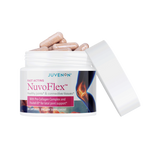
Exercise is one of the cornerstones of a healthy lifestyle. We all know we need more of it! But it’s not just more exercise that we need. It’s also more of the most beneficial types of exercise.
Zone 2 training is a powerful form of exercise that boosts cardiovascular health and enhances physical fitness. If you’re not already doing this type of training, it’s time to add it to your fitness regimen. And if you’re new to exercise, zone 2 training is a great place to start.
It’s more than just cardio. Zone 2 training offers specific benefits if you follow certain principles and understand how it works. Let’s take a closer look at:
- What is zone 2 training
- The science behind zone 2 training
- Why zone 2 training is so beneficial
- How to calculate your zone 2 training heart rate
- Ways to get the most out of your training and how Juvenon BloodFlow-7 can help
What is Zone 2 Training?
Put simply, zone 2 training is a low-intensity cardiovascular exercise performed for a long period. While you may just be hearing about zone 2, the concept has been around in the sports science realm for a long time. It’s not new, and it’s not complicated, but its importance is often overshadowed by the high-intensity forms of exercise that are popular in many fitness circles.
While high-intensity exercise has its place, zone 2 training has specific benefits that are very different from intense bouts of heart-pumping movement. Each type of exercise affects the body in various ways, and part of this has to do with how hard your heart and muscles work.
Exercise can be broken into 5 different heart rate “zones” that indicate the effort your heart exerts to pump blood to your body. The zones are based on your maximum heart rate, meaning the maximum intensity your heart and blood vessels can handle during exercise.
Your heart rate zones are determined as a percentage of your maximum heart rate.
|
Zone 1 |
50-60% |
|
Zone 2 |
60-70% |
|
Zone 3 |
70-80% |
|
Zone 4 |
80-90% |
|
Zone 5 |
90-100% |
Each zone is expressed as a percentage because everyone's maximum heart rate is different. Factors that influence your maximum heart rate include:
A zone 2 training heart rate is a modest 60-70% of your maximum. When exercising in this zone, you should be able to carry on a conversation without feeling breathless or overexerted. Because it’s not overtaxing, you can maintain zone 2 for longer periods of time without breaks, and this is where its benefits come in.
The Science Behind Zone 2 Training
When you exercise, your body’s need for fuel increases. The more you move, the more energy your muscles require to fuel the extra work of contracting and producing movement.
Fuel comes from two primary sources in the body (3,4):
- Carbohydrates from glucose in the bloodstream and glycogen (a stored form of glucose) in the muscle and liver.
- Fat from within the muscles and adipose (stored fat) tissues.
The type of fuel your body uses depends on how intensely you exercise and for how long. The harder you work, the more carbohydrates you burn for fuel, as they provide energy the fastest. When you exercise at lower intensities, you use more fat for fuel as you do not need energy to be supplied as rapidly.
The body has only about 1,000-2,000 calories worth of energy in glycogen stores. But the calories in fat stores, even in slim people, are in the tens of thousands. That’s a lot of energy available to you as long as your body is efficiently using it.
It’s an advantage to burn both carbohydrates and fat as energy. When you can effectively use both forms of fuel, it’s called metabolic flexibility, and it’s an indicator of how well your metabolic systems adapt to changing conditions, whether at rest or during activity. (5)
If your body struggles to switch between burning carbohydrates and fat, it’s known as metabolic inflexibility, and it’s associated with many chronic disease conditions:
- Obesity
- Pre-diabetes
- Type 2 diabetes
- Metabolic syndrome
- Insulin resistance
Improving metabolic flexibility is key to promoting good health and preventing disease. Exercise is a primary tool to make your body’s pathways for burning fuel more efficient and flexible. And the primary reason exercise, and specifically exercise in zone 2, has such a big impact is because of your mitochondria.
Zone 2 Training and Your Mitochondria
Mitochondria are the components of cells that produce energy by converting carbohydrates or fat into ATP (adenosine triphosphate), the useable form of fuel for your cells. Different tissues in your body have different amounts and types of mitochondria to support that tissue's unique needs.
Muscles contain a lot of mitochondria because they need a lot of energy. But not all muscle is the same. There are two primary types (6):
- Type 1 muscle fibers, known as “slow twitch” muscles, have a lot of diverse mitochondria and are highly efficient at burning fat for fuel. This type of muscle fiber dominates in zone 2 training.
- Type 2 muscle fibers, known as “fast twitch” muscles, have fewer mitochondria but are very good at converting carbohydrates to rapid energy. This type of muscle fiber dominates during high-intensity training in higher heart rate zones.
Your muscles are adaptable, meaning they respond to the loads you place on them. Lifting heavy loads strengthens your muscles, one of the most significant benefits ofstrength training. But your muscles don’t only get stronger with exercise. They also get better at providing the energy you need to fuel movement.
When you do zone 2 training, your type 1 muscle fibers respond by producing more and better-quality mitochondria optimized to burn fat for fuel. (7) High-intensity training optimizes your body for burning carbohydrates to produce short, intense bouts of effort. Both adaptations matter! To be metabolically flexible, you want all your mitochondria to function at peak capacity.
Benefits of Zone 2 Training
- Increases fat-burning mitochondria
- Improves metabolic flexibility
- Reduces and prevents insulin resistance
- Improves VO2 Max (a measure of heart health and fitness)
- Promotes vascular health
- Protects longevity (8)
- Reduces the risk of chronic diseases such as obesity, type 2 diabetes, heart disease, high blood pressure, and dementia
- Accessible for most people regardless of fitness level
- Less risk of overtraining and injury (7)
How to Calculate Your Zone 2 Training Heart Rate
Everyone's zone 2 training heart rate is different. Using some basic information, getting a rough estimate of the heart rate range that constitutes zone 2 for you is simple.
One quick and easy way is to subtract your age from 220. (9) This gives you an estimate of your maximum heart rate. Then, multiply your maximum heart by 0.6 - 0.7 to find your zone 2 range.
For example, if you’re 58 years old:
220 - 58 = 162 (maximum heart rate)
162 x 0.6 = 97.2
162 x 0.7 = 113.4
In this example, your zone 2 training heart rate range would be 97-113 beats per minute (BPM). While this is not a perfect measure, it can provide a place for you to begin. Some fitness trackers provide information on heart rate ranges, and this may be more accurate, especially as your heart rate adapts over time.
Another way to determine if you’re staying in zone 2 is to assess whether you can comfortably carry on a conversation. You should feel like your heart rate is elevated, but not so much that you can’t chat with the person next to you. In zone 2, you should be able to continue the activity for at least 30 minutes without needing a break.
Put together, these markers will help you get into that all-important zone.
Get the Most Out of Zone 2
When you’re first starting out with zone 2 training, it’s helpful to wear a heart rate monitor to track whether you are achieving and maintaining the correct heart rate. It’s common for people to easily overdo the intensity and miss the benefits of an extended time in zone 2.
In this case, harder is not better. It’s long and low. The real work is happening internally.
Exercise Modalities for Zone 2 Training:
- Long, slow bike rides
- Easy paced jogs
- Brisk walks
Zone 2 training tips:
- Depending on your goal, aim for 2-4 zone 2 training sessions per week.
- Make your sessions long. 45-90 minutes is ideal.
- Take your training outside. You may find it easier to pace yourself and complete a long session in nature rather than in a gym.
- Find a training partner. Zone 2 training sessions are a great time to chat!
- Remember to vary your workouts. A blend of zone 2, high-intensity, and strength training provides an optimal balance and the best metabolic flexibility.
- Eat a balanced diet to fuel your workouts and recovery.
- Consider a supplement to support your cardiovascular system and enhance your adaptation to zone 2 training.
Juvenon BloodFlow-7 is a perfect complement to a zone 2 training program. Working muscles require quality blood flow to supply oxygen and fuel. Juvenon BloodFlow-7 contains natural plant-based ingredients that boost the production of nitric oxide, an important compound that promotes vascular health. Nitric oxide may also boost mitochondrial function and synthesis by stimulating enzymes associated with mitochondria production. (10)
Juvenon BloodFlow-7 contains L-arginine (an amino acid converted to nitric oxide), green coffee bean extract, and L-citrulline, ingredients that together are known to increase nitric oxide production and will support your zone 2 training efforts. BloodFlow-7 also contains potent antioxidants that protect mitochondria from oxidative damage and decay.
Takeaways
Training in zone 2 is a powerful way to support metabolic flexibility, prevent disease, and enhance longevity. While high-intensity exercise gets a lot of attention, the benefits of zone 2 training should not be underestimated.
A balanced exercise regimen should include this unique type of training to maximize your workout benefits. Combined with a healthy diet and our BloodFlow-7 supplement, zone 2 training can produce incredible results.
References
- Whyte GP, George K, Shave R, Middleton N, Nevill AM. Training induced changes in maximum heart rate.Int J Sports Med. 2008;29(2):129-133. doi:10.1055/s-2007-965783
- Zavorsky GS. Evidence and possible mechanisms of altered maximum heart rate with endurance training and tapering.Sports Med. 2000;29(1):13-26. doi:10.2165/00007256-200029010-00002
- Mul JD, Stanford KI, Hirshman MF, Goodyear LJ. Exercise and Regulation of Carbohydrate Metabolism.Prog Mol Biol Transl Sci. 2015;135:17-37. doi:10.1016/bs.pmbts.2015.07.020
- Hargreaves M, Spriet LL. Skeletal muscle energy metabolism during exercise [published correction appears in Nat Metab. 2020 Sep 10;:].Nat Metab. 2020;2(9):817-828. doi:10.1038/s42255-020-0251-4
- Goodpaster BH, Sparks LM. Metabolic Flexibility in Health and Disease.Cell Metab. 2017;25(5):1027-1036. doi:10.1016/j.cmet.2017.04.015
- Dong H, Tsai SY. Mitochondrial Properties in Skeletal Muscle Fiber.Cells. 2023;12(17):2183. Published 2023 Aug 30. doi:10.3390/cells12172183
- Langan SP, Grosicki GJ. Exercise Is Medicine…and the Dose Matters.Front Physiol. 2021;12:660818. Published 2021 May 12. doi:10.3389/fphys.2021.660818
- O'Keefe JH, O'Keefe EL, Lavie CJ. The Goldilocks Zone for Exercise: Not Too Little, Not Too Much.Mo Med. 2018;115(2):98-105.
- https://www.heart.org/en/healthy-living/fitness/fitness-basics/target-heart-rates
- Dyakova EY, Kapilevich LV, Shylko VG, Popov SV, Anfinogenova Y. Physical exercise associated with NO production: signaling pathways and significance in health and disease.Front Cell Dev Biol. 2015;3:19. Published 2015 Apr 2. doi:10.3389/fcell.2015.00019


















